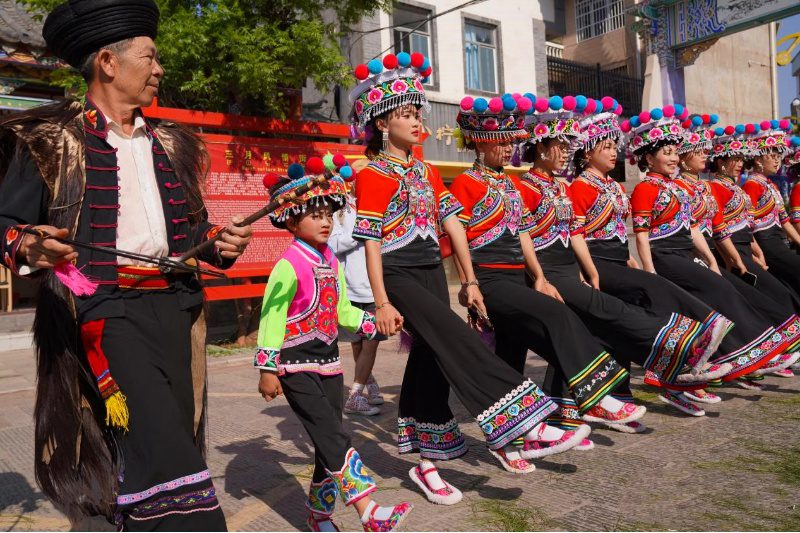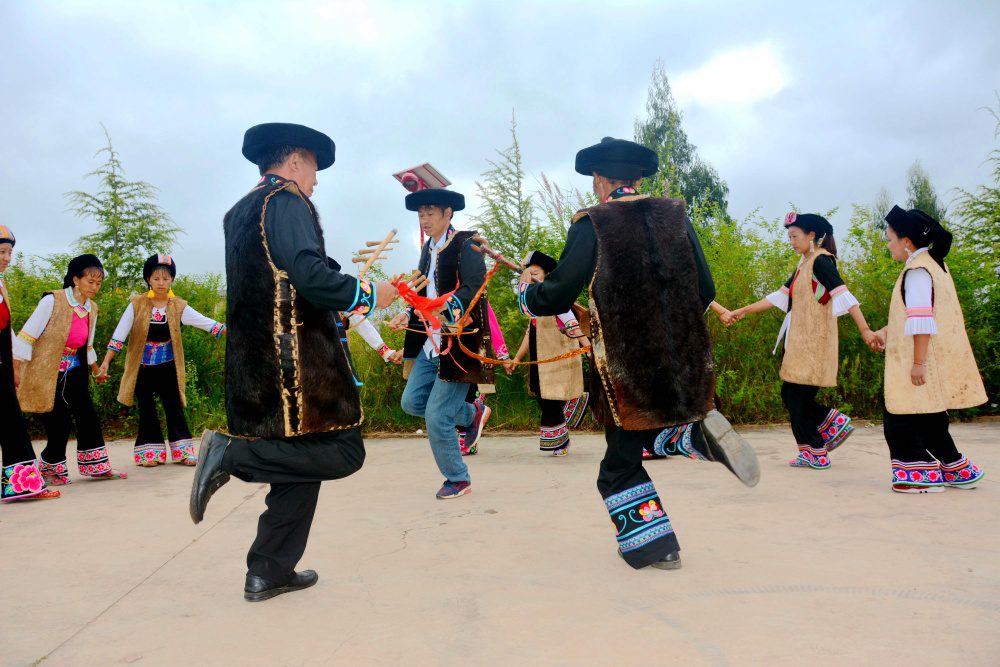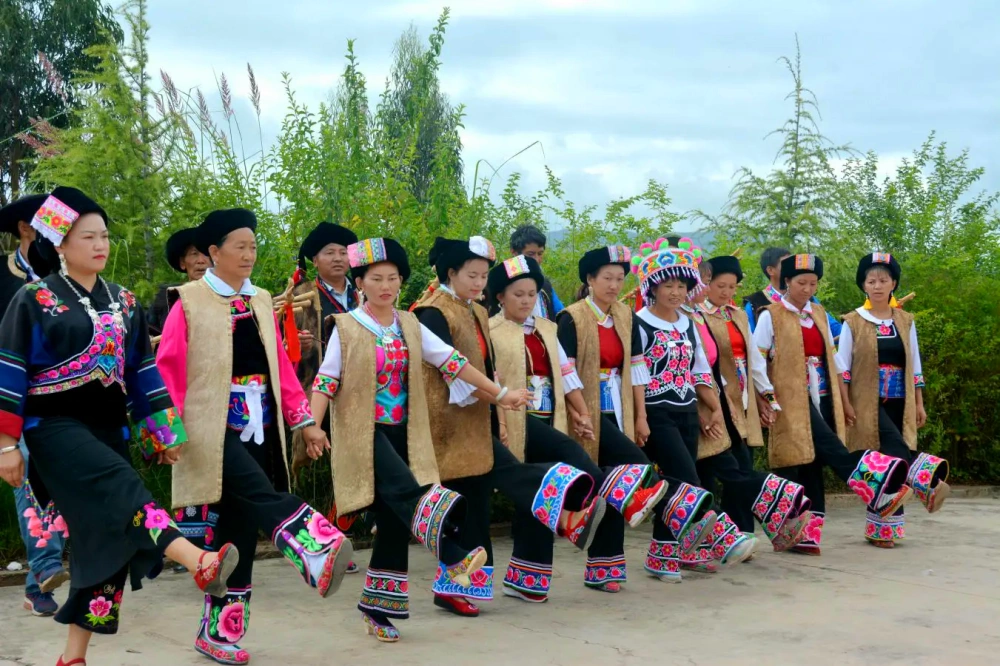Lawan Village of Fengtun Town in Mouding County, Chuxiong
Chinese Name: 牟定县凤屯镇腊湾村
English Name: Lawan Village of Fengtun Town in Mouding County, Chuxiong
Lawan Village of Fengtun Town is famous for Magu Dance of Yi Ethnic Minority in Mouding County.
Lawan Village (腊湾村), located in Fengtun Town (凤屯镇) of Mouding County (牟定县), is part of Chuxiong Yi Autonomous Prefecture (楚雄彝族自治州) in Yunnan Province, China. Situated 36 kilometers from the town government, the village is accessed by 30 kilometers of dirt roads and 16 kilometers of paved roads. The village is 31 kilometers from the county seat, and is home to 22 villager groups, including Juizi, Baishahe, and Qijia.
Key Features
1. Geography and Climate
Lawan Village is located in the Zhaizi Mountain area (寨子山), at an elevation of 2750 meters, making it the highest point in the county. The climate remains cold year-round, similar to the month of December, earning the village the name “Lawan,” which means “mountain bay in winter” in the Yi language. The winding road to the village features nine bends and eighteen turns, enhancing its mystique.
2. Ethnic and Cultural Heritage
Lawan is a predominantly Yi ethnic (彝族) village, with a deep cultural history. The village is renowned for its ancient customs and ethnic traditions, particularly in dance and storytelling. Lawan is home to the Magu Dance (玛咕舞), a 400-year-old dance form often referred to as a “living fossil” of ancient human dance. It is performed by elderly villagers and involves a series of 24 stomping steps that symbolize the 24 solar terms of the traditional Chinese calendar.
In addition to dance, the village celebrates its rich heritage through the Meige Culture (梅葛文化), an epic that narrates the creation myths of the Yi people. This cultural gem is recognized as a national intangible cultural heritage.
Local Resources and Economy
1. Agricultural and Natural Resources
Lawan’s main agricultural products include corn, white kidney beans, and potatoes, grown on the village’s 1991 acres of farmland. The surrounding 55,141.5 acres of forestland contribute to the village’s rich natural resources, supporting a variety of wildlife, plants, and medicinal herbs.
2. Cultural Preservation
The village has established the Magu Dance Art Troupe (玛咕舞艺术团) with over 40 members, and a Yi Cultural School (彝寨传习所) to pass on traditional knowledge and arts, such as the Magu Dance and Yi embroidery. These efforts ensure that the ethnic culture continues to thrive and is passed down to future generations.
Festivals and Traditions
1. Magu Dance
The Magu Dance has been a vital part of the village’s traditions for more than four centuries. The dance, which is performed by the elderly first and then joined by the youth, symbolizes respect for ancestors and expresses the deep connection to nature and agriculture. It is accompanied by the three-stringed instrument (三胡), which adds a haunting melody to the performance. The 24 stomping steps are deeply tied to the 24 solar terms, reflecting the cyclical nature of agricultural life.
In 2017, the documentary “Lawan Dancers” (腊湾舞者), directed by the renowned Chinese filmmaker Li Yawei (李亚威), was produced to showcase this endangered cultural dance to both domestic and international audiences.
2. Ethnic Unity Day
The Ethnic Unity Day (民族团结日) is an annual celebration in Lawan, held on the 15th day of the second lunar month. It has been celebrated for over 30 years and involves vibrant festivities such as the Left-Foot Dance (左脚舞) and the trading of ethnic handicrafts, including Yi embroidery (彝族刺绣). This day serves as a symbol of the harmony and unity between the Yi people and their neighbors.
Cultural and Ecological Preservation
Lawan Village is committed to preserving its traditional culture and ecological environment. The village has created spaces for cultural exchange, including the Magu Yi Village (玛咕彝寨) and the Meige Training Center (梅葛传习所). Additionally, the village works closely with the local government to provide training programs for the transmission of traditional crafts and arts to younger generations.
Festivities and Cultural Activities
Every year on the 15th day of the second month of the lunar calendar, Lawan Village in Fengtun Town, Mouding County, and Xinmin Village in Qianchang Town, Yao’an County, celebrate a day of joy with singing and dancing. At the cultural square, villagers from both communities don festive attire, holding hands and standing shoulder to shoulder. They form circles or lines, playing the four-stringed lute and dancing the Left-Foot Dance. Along the roadsides, ethnic costumes, embroidery, handicrafts, and various daily necessities are actively traded, bringing smiles to the faces of market-goers. In the village activity room, officials from both villages gather, enjoying a harmonious and joyous atmosphere.
“Magu Dance”: Preserving and Promoting Traditional Ethnic Culture
Lawan is home to a primitive, unadorned ethnic dance called “Magu Dance,” which has been passed down for over 400 years and is now one of the nearly extinct dance forms, often referred to as the “living fossil of ancient human dance.” “Magu” translates to “the dance of the elderly” in Chinese. According to historical records, this dance originated from the ancient Bimo ritual dance, which was believed to invoke the power to rescue people from leopards. The Yi people of Lawan later adapted and preserved the dance. Accompanied by a three-stringed instrument, the dance features a haunting, lingering melody played by alternating the strings, creating a poignant atmosphere. Dancers move gracefully and slowly, exuding elegance. Scholars believe that the 24 stomping steps in the dance represent the 24 solar terms, closely related to agricultural life, with some gestures reflecting ancient sacrificial rituals. The complete sequence of “Magu Dance” includes 24 stomping steps, starting with the opening dance “Wuzha Ruo,” followed by sequences like “Ruozha Ruo,” “Qizha Ruo,” “Caizha Ruo,” “Tizha Ruo,” and “Mazha Ruo,” ending with the 24th step, seamlessly connected and progressively unfolding.
Lawan Xiangshui River Stone Arch Bridge
The Lawan Xiangshui River is spanned by a stone arch bridge that has been weathered by time, with its surface and railings showing signs of erosion. In the tales of Lawan’s landscape, Yi ancestors used their wisdom to challenge corrupt officials, requiring all who crossed the bridge to dismount from their horses or carriages, hence the name “Dismounting Bridge.” As time passed, the bridge’s original purpose faded, replaced by a modern road bridge. However, this old bridge remains as a testimony to the merchants and traders who once passed through, symbolizing the enduring bond between people and the land.
Travel Information
1. Best Time to Visit
The best time to visit Lawan Village is during the winter and spring (November to March) when the village’s cultural activities, such as the Magu Dance and traditional festivals, are in full swing. This period also offers a unique opportunity to experience the Yi people’s customs in their natural, unspoiled environment.
2. Transportation
Lawan is accessible via private car from Mouding County or by local village buses. Visitors can drive to the county town and then transfer to a local bus that reaches the village.
3. Accommodation
There are Yi-style guesthouses (彝家民宿) in the village that offer an authentic experience, but reservations should be made in advance to ensure availability.
4. Local Cuisine
Traditional dishes such as bitter buckwheat cake (苦荞粑粑) and Lawan ham (腊湾火腿) are specialties of the area and offer visitors a taste of the local Yi cuisine.
Travel Tips:
Lawan is located 31 kilometers northwest of Mouding County town, at the tri-junction center of Nanhua, Yao’an, and Mouding. It was a historical post station for salt transportation to Xiangyun, Xiaguan, and Zhaotong during the Ming and Qing Dynasties and an important passage on the Southern Silk Road.
Lawan connects with the mountain bay areas bordering Yao’an County to the north, situated along a ridge running north to south. Houses with dragon-scale-like blue tile roofs are arranged from low to high, surrounded by undulating mountains shrouded in clouds and mist. The ancient, magical Yi elders’ dance awaits to bring the ancient music back to life, while the mysterious “Maiden Room” invites visitors to unveil its shy veil.

 7 Days GolfingTour
7 Days GolfingTour
 8 Days Group Tour
8 Days Group Tour
 8 Days Yunnan Tour
8 Days Yunnan Tour
 7 Days Shangri La Hiking
7 Days Shangri La Hiking
 11 Days Yunnan Tour
11 Days Yunnan Tour
 6 Days Yuanyang Terraces
6 Days Yuanyang Terraces
 11 Days Yunnan Tour
11 Days Yunnan Tour
 8 Days South Yunnan
8 Days South Yunnan
 7 Days Tea Tour
7 Days Tea Tour
 8 Days Muslim Tour
8 Days Muslim Tour
 12 Days Self-Driving
12 Days Self-Driving
 4 Days Haba Climbing
4 Days Haba Climbing
 Tiger Leaping Gorge
Tiger Leaping Gorge
 Stone Forest
Stone Forest
 Yunnan-Tibet
Yunnan-Tibet
 Hani Rice Terraces
Hani Rice Terraces
 Kunming
Kunming
 Lijiang
Lijiang
 Shangri-la
Shangri-la
 Dali
Dali
 XishuangBanna
XishuangBanna
 Honghe
Honghe
 Kunming
Kunming
 Lijiang
Lijiang
 Shangri-la
Shangri-la
 Yuanyang Rice Terraces
Yuanyang Rice Terraces
 Nujiang
Nujiang
 XishuangBanna
XishuangBanna
 Spring City Golf
Spring City Golf
 Snow Mountain Golf
Snow Mountain Golf
 Stone Mountain Golf
Stone Mountain Golf














